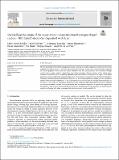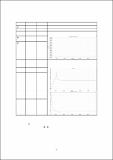Por favor, use este identificador para citar o enlazar a este item:
http://hdl.handle.net/10261/280869COMPARTIR / EXPORTAR:
 SHARE SHARE
 CORE
BASE CORE
BASE
|
|
| Visualizar otros formatos: MARC | Dublin Core | RDF | ORE | MODS | METS | DIDL | DATACITE | |

| Título: | Unravelling the origin of the capacitance in nanostructured nitrogen-doped carbon - NiO hybrid electrodes deposited with laser |
Autor: | García Lebière, Pablo; Gyorgy, Eniko CSIC ORCID; Logofatu, Constantin; Naumenko, Denys; Amenitsch, Heinz; Rajak, Piu; Ciancio, Regina; Pérez del Pino, Ángel CSIC ORCID | Palabras clave: | Carbon nanostructures Electrochemical capacitors Hybrid electrodes MAPLE SPECS |
Fecha de publicación: | 1-jun-2022 | Editor: | Elsevier | Citación: | Ceramics International 48(11): 15877-15888 (2022) | Resumen: | The full knowledge of the charge storage mechanisms occurring in complex composite electrodes is key for the straightforward development of advanced electrochemical capacitors. In this work, hybrid electrodes composed of reduced graphene oxide, multiwall carbon nanotubes and NiO nanostructures were fabricated through reactive inverse matrix assisted pulsed laser evaporation technique. Nitrogen doping of the carbon nanostructures was carried out by introducing ammonia, urea and melamine precursors in the target. The N-doped graphene electrodes exhibited a significant capacitance enhancement as compared to non-doped ones. This fact is commonly ascribed to faradaic mechanisms. However, our structural-compositional studies point to a significant change of the structural configuration of the composites at the nanoscale upon the nitrogen functionalization as the source of the electrodes’ capacitance enhancement. The composites fabricated with urea precursor exhibited the highest capacitance, and this fact was associated with the presence of pyridinic N groups that triggered the formation of a high amount of structural defects (vacancies – boundaries) and microporosity, not observed in the samples synthesized with other precursors that mainly contained pyrrolic-graphitic N. | Versión del editor: | http://dx.doi.org/10.1016/j.ceramint.2022.02.128 | URI: | http://hdl.handle.net/10261/280869 | DOI: | 10.1016/j.ceramint.2022.02.128 | ISSN: | 0272-8842 |
| Aparece en las colecciones: | (ICMAB) Artículos |
Ficheros en este ítem:
| Fichero | Descripción | Tamaño | Formato | |
|---|---|---|---|---|
| Garcia_CeramInt_2022_editorial.pdf | Artículo principal | 7,52 MB | Adobe PDF |  Visualizar/Abrir |
| Garcia_CeramInt_2022_suppl_editorial.pdf | Información complementaria | 1,1 MB | Adobe PDF |  Visualizar/Abrir |
CORE Recommender
SCOPUSTM
Citations
2
checked on 28-abr-2024
WEB OF SCIENCETM
Citations
2
checked on 27-feb-2024
Page view(s)
30
checked on 02-may-2024
Download(s)
40
checked on 02-may-2024
Google ScholarTM
Check
Altmetric
Altmetric
Este item está licenciado bajo una Licencia Creative Commons

